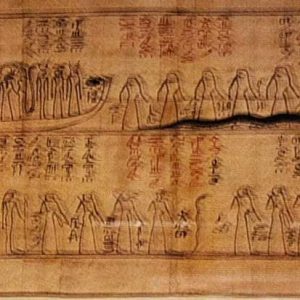
The Myth of the Daily Cycle
Ra’s journey every night through the underworld “Duat” and his struggle against the forces of chaos there so that the sun appears in the morning again on the world. Ra, the rider of the sun boat, and the snake Apophis escapes from it.
From Abu Simbel Temple,
Ramses II offers our offerings to Ra.
This legend explains the struggle of Ra every night against the forces of chaos and evil represented in a large snake called Apophis so that the sun (Ra) could appear the next morning high in the sky.
Ra is considered the sun god, and when the sun disappears every evening, the god Ra changes his mode of transportation and rides a sacred boat through which he crosses the Nile under the earth. Ra crosses during that journey 12 gates that represent 12 hours, which are the number of hours of the night (from 5 pm to 5 am) in the underworld, and this year is called Duat, and it resists the forces of chaos and dangers facing its solar craft.
The god Set assists him during that journey as he stands on the boat’s bow, and the snake threatens Apophis with his spear so that it does not approach. And after that journey every night in the underworld, Ra reappears in the morning and casts his rays that give life to humans on the surface of the earth. This resurrection of Ra, the representative at the rise of the sun every morning, was considered by the ancient Egyptian as a resurrection of man and a sign of the victory of the god Ra over the forces of chaos during his night journey.
The twelve gates decorated the walls of the graves of the pharaohs during the New Kingdom with colours. They were also written on papyrus in a book called Kitab al-Akhirah (Amadwat) and in shortened versions of it in the families that followed until the family of 30 at least. Some texts from it are inscribed on the coffins of the dead, especially during the Pharaohs of the Dynasties 18 to 30. Each chapter of the book belongs to a specific hour of the night and what happens in it in the underworld.
And this conflict between Ra and the serpent Afobis every evening since the sunset of the sun in the evening and its appearance every morning is the myth of the daily cycle in ancient Egyptian mythology. These texts were known since the Old Kingdom, and during the dynasties of the Old Kingdom, these texts were written on the walls of the tomb chambers and are known as the Pyramid Texts.
The cult of Ra (the sun) appeared in Heliopolis in the north. It was associated with the return of the daily cycle, sometimes symbolized by Ra-Horakhti (Horus, with the sun disk on his head) during the Fifth Dynasty, and temples were built for him in Ain Shams and Abu Sir. Among the most important symbols of it are the obelisks erected in his honour and the top of which is gilded with gold. After that, the worship of Ra reached Thebes, and several temples were erected there, and several obelisks, and among the king’s permanent titles was the title of “Ibn Ra”. Ramses II also called him the Temple of Abu Simbel.


Comment (0)